#Oni wives
Explore tagged Tumblr posts
Text




Seeker, do you ever come to wonder, If what you're looking for is within where you hold? ✾
#What do you mean we could have had Oni wives in an alternate universe?!#not canon but an au#Oni Samura Jade AU#lego ninjago#ninjago#ninjago fandom#ninjago art#my art#art#fanart#lego ninjago fanart#ninjago oc#oc: samura jade#Ninjago oni#mystake oni form#ninjago oni art#oni mystake#mystake oni#Oni#oc shipping: JadeTea#mystake ninjago#mystake#ninjago mystake#Oni wives
83 notes
·
View notes
Text












#simblr#ts4#sims4#occult sims#Oni save#Prince shops for his wives#Prince Razer#Mace#Lueana#this is kind of a modern au i just really thought itd be funny to use these two very simmilar skirts
3 notes
·
View notes
Text

Flustered dingus noises.

Meanwhile, Oni is very, very much ready.
#Dash Commentary : Operator's Observations#Bowen Chuuno : The Mighty Atom#Oni Shinpachi : The Wild Horse#two kinds of people#when it comes to marking their princess gfs / fiances / wives#XD
1 note
·
View note
Text
DEMON SLAYER SERIES MASTERLIST
My series collection. All have two or more parts you can read.

The Toll Of Desire : Yandere Kizuki x Oiran Reader
Bleeding Moonlight : Oni Kokushibo x Oiran Reader
Monstober : Monster Kny characters x Reader
Yantober : Yandere kny characters x Reader
Mermay Madness : Mermaid kny characters x Reader
Kaigaku Week : Kaigaku x Reader
Demonic Angelicy : Karaku x Oc
Karaku/Hantengu+ Clones x Angel (OC) Stuff
A Lover's Circle (Poly Haishira x Reader)
The Hand That Guides : Demon King Kagaya Ubuyashiki x Reader Au
Abyssal : Mermaid Kokushibo x Reader Collab With @lavenderdropp
Obsession 憑 :Yandere Yoriichi x Reader x Yandere Kokushibo/Michikatsu
Fleeting Memories : Demon Yuichiro Tokito Au
Monster Bride : Monster Twelve Kizuki x Reader
Demon Bride : Reverse Harem Twelve Kizuki x Reader
Demon Bride Lost Bits : None Cannon Endings To Demon Bride
Waning Obsession(Yandere Kokushibo x Reader)
In The Moon's Shadow(Yandere Kokushibo x Reader)
Eclipsed Starshine(Yandere Kokushibo x Reader)
Let's Summon An Oni! : Oni Kokushibo x Reader
Promise : Yokai Yoriichi x Reader x Yokai Kokushibo
Demonstober : Monster Kny Characters x Reader
Twelve Days Of Kny : Christmas themed kny ships
Quite A Handful : Hantengu+ Clones x Wife Reader
Oblivious Crushes : Hantengu Clones x Mitsuri Modern Au
A Rock And A Hard Place : Akaza x Reader x Douma With A Side Of Rengoku x Reader
Everyone Wants A Brother Like You : Slice Of Life Nezuko Ships
Love Is Blind : Kagaya Ubuyashiki x Reader Soulmate Au
Ocean Deep : Uzuren + Wives x Reader Mermaid Au
#demon slayer#kimetsu no yaiba#kny#kimetsu gakuen#monster bride#Demon Bride#Demon Bride Lost Bits#Ocean Deep#A Lovers' Circle#in the moon's shadow#Eclipsed Starshine#Waning Obsession#obsession#abyssal#a rock and a hard place#Everyone Wants A Brother Like You#love is blind#fleeting memories#the hand that guides#Promise#oblivious crushes#quite a handful#Demonstober#Twelve Days Of Kny#Demonic Angelicy#Mermay madness#Yantober#Monstober#Kaigaku Week#The Toll Of Desire
49 notes
·
View notes
Text
tis' the season , arataki itto 𓆝



synopsis from the marine lover -> when spending the holiday season with someone like your lover, you never know what to expect; but it just makes it that much better.
phylum echinodermata -> genshin impact - inazuma
characters -> itto x reader, the arataki gang appear throughout the story, super secret guest star appearances (kat will know).
word count -> 2.1k
content -> one shot; fluff - female reader
water levels -> all safe, no warnings
heyyyyy kat fancy seeing you here ahahaha....on my secret santa post...haha...@yyuangss, this was the biggest secret I had to keep from you EVER you have no idea. this is our third year participating in this secret Santa (to which, thank you @2024gisecretsanta for hosting this amazing event ever year.) and we always joked how fun it would be if we got each other one year, and I was lucky enough to have gotten you. I seriously could never ask for a better best friend than you, and being able to give you a piece of writing considering you were the first writer I ever looked up to is such a big circle moment. I love you stink stink <3

inazuman winters tend to cover the towns in thick veils of pristine white snow, the sky up above a deeper gray; one could say it was a similar shade to months back when the archon issued the sakoku decree. winter time was just another cold reminder of how it used to be. keyword: it.
the naku weed glowed that much brighter - the leaves of the sakura trees seemed more vibrant - even the amakumo fruit tastes sweeter. ever since the decree lifted, everything seemed to fall back into place.
most of all; winter in inazuma was a stark contrast to its warm, sunny counterpart. at least this year, the streets are filled with decorative lights, the laughter of children, and the remembrance of old holiday traditions. some elders even whispered throughout the streets that there might be a chance of snowfall.
“old wives tale,” you muttered. but you couldn’t deny it was a chiller morning than usual. your blinds were pulled in, so you couldn’t exactly see the outdoors. but it couldn’t be, no?
taking yourself away from the warm spot by the heated stove, reluctant of course, you made your way to your front door, your warm beverage in hand. stepping even a foot away, you missed the warmth, but you couldn’t deny the increased coldness as you walked through your home, especially the freezing sensation when you laid your hand on the doorknob.
cracking the door open, you couldn’t believe it, was it really—
well, not like you could see. considering a sudden ball struck your face, cold, cold, very cold. as it slowly slid off your face, covering your lashes in a thick sheet of ice— ah yes, snow. landing straight into your delectably warm drink with a loud plop.
a vibrant, exuberant laugh filled your surrounding area, maybe it was the fact your eyelids were shut that your ears picked up on the sound louder and quicker. but you knew, you didn’t need to open your eyes to know who it was.
“WOO!” followed soon after, continued with more laughter, “babe, babe! it really is snowfall! look, look. see? i even made a snowball!” your boyfriend - the self-proclaimed one-and-oni arataki itto; head of the arataki gang was at your front door.
who threw a snowball in your face.
“itto.” you muttered, your eyes still closed shut as you heard him walking towards you, his shoes squeaking against the apparent snow you have yet to see.
“yeeeesss?” he responded in a higher-pitched voice. it was louder, so you could only assume - granted with the footsteps - he was now standing in front of you.
you sighed, taking your free hand to wipe the remaining snow that had yet to melt off your eyelids. “did you just throw a snowball at me?” you muttered, opening your eyes. at least you opened them at a good time to see itto’s expression fall from excitement to realization, seemingly needed for you to verbally communicate what he did.
“i-i. well. you see,” he laughed, starting to shake his hands in front of you. “it wasn’t meant for your face, i swear! it was meant for the…the door!” he pointed, then quickly got to dusting off the snow that had fallen on your shoulders, coincidentally falling into your mug.
“it’s not scalding hot, it should’ve cooled down. it should be cool by now, should be cool by now—“ you contemplated, looking down at the snow covering your previous warm beverage, wondering if you should throw it at itto.
“oh, hey! now it looks like it has whipped cream in there—“
yeah. you threw the drink at him.

“itto, why are you cold!” you hissed as he put his hand over yours that was warmly tucked into your jacket’s pocket. not like you’d tell him to move it though
“because you banished me outside!” he argued back. “you left me out in the cold. how could you be so heartless,” he sighed dramatically.
if your hands weren’t so cold, you’d rub your nose. instead, you compromise with a sigh, “because you threw a snowball at me.” you mumbled, but moved the hand in your pocket to hold his, the former immediately grinning at you, squeezing your hand.
“pfft, forgive and forget,” he laughed off pulling your now intertwined hands out of your jacket pocket to drag you towards the town.
“you really shouldn’t run,” you tried to argue, but when did he ever listen. it wasn’t like your place was far from town - it could have been a nice simple walk instead of a marathon run.
but oh no, karma had other plans.
as itto graciously proceeds to drag you, ignoring all protests especially the ones that involved the words ‘stop!’ or ‘slow down!’
of course he wouldn’t notice he was running straight through a sheet of ice he would inevitably slip on. and of course he’s going to slip, and fall, and take you down with him. and of course he is going to take that fall undoubtedly yelling for all of inazuma to hear.
at least your fall wasn’t too bad, but when you turned to see him, of course his tongue got conveniently stuck onto a poll.
you tried to warn him. you really did.
“ah vittle healp hear?” he tried to speak his best, but it wasn’t like he could properly pronounce his words when his tongue was getting frozen onto a pole. he tried to pull it back, but that was a no go.
“let me go get some hot water,” you sighed, starting to walk back towards your place.
sure you were going to get some hot water, but there was no way you weren’t going to also grab your kamera.

one thing about the winter time in inazuma, it gets dark very quickly, and even colder than when the sun was out. you know what excuse that made for though? a good-old-fashioned fire pit.
itto led you through the streets of the town - making sure not to slip on more ice and risk yet another picture - but uncharacteristically stopped his quick-paced movements when you both reached the lit-up portions of town.
it was beautiful to say the least. houses decorated with colorful lights, the children running around playing with each other, neighbors conversing between each other - it was like your small town was brought back to life.
your favorite had to be itto running around with the children though, playing along with them. if you didn’t know any better, or if he wasn’t so tall, you’d think he’s one of them. of course he made sure everyone was included: that’s just the man he is.
eventually when he had his fill, he comes back around to you, his nose and cheeks dusted in a rosy color, definitely from the cold. he grinned at you as you redid his scarf. would he usually protest against such frivolous manners? yes, but not when it came from you.
“you’re cold.” you stated the obvious.
“i feel warmer already, ‘cause i’m with you.” he said so simply, with no need to think.
maybe you were the one that got warmer, because you couldn’t deny the warmth filling your cheeks, and he sure wasn’t going to let you live that down.

eventually you’ll make it to the campfire in the middle of the town. eventually. but hey, you made it! sure, it took a few detours, like itto finding his ‘new champion’, but you also got a pretty sakura bloom out of it, gently resting in your hair where itto placed it.
you sighed, taking in the nice, toasty warmth from the fire. surely you’d smell like the smoke, but you wouldn’t, no, couldn’t trade this moment. especially not when you can see your boyfriend running over with two sticks, a marshmallow on each end.
itto was a lot of things, a good companion, a goofball sole would say, an amazing lover to you, but you did not expect him to be that good at roasting marshmallows. perfectly golden, soft, and warm. you on the other hand? not so good at it. well, clearly. could you even call that a marshmallow when it resembles a lump of coal?
if you knew any better, you’d think the two girls over on the other side of the fire were laughing at your attempt of roasting a marshmallow, but something told you it had less to do with you and more to do with the woman in the long, brown skirt trying to knock the ball away from the woman in glasses.
but like you said, itto was a lot of things. of course he would give you his perfectly roasted marshmallow and take your…marshmallow. all with his perfect grin as he assembled the s’more. never once complaining, giving you a toothy smile.
“this is soo good…!” he exclaimed. you had to wipe the corner of his lip that was filled with chocolate, and he takes the opportunity to snag a kiss to your hand.
that was just the type of man he was.

but sadly, you had your responsibilities
of course you complained on the walk back to your place - you’d much rather stay with him. but you had to do what you had to do. so you both - reluctantly - parted ways one he dropped you off. and while yes, itto could’ve spent some time with you, you knew you’d get quickly distracted. it was impossible not to!
time passed, and you couldn’t help but hear a sudden thud against your door. and again. and again. you walked over to your door, cautiously opening it. seemed like you weren’t the only cautious one, as itto had his hand winded back, hesitantly with a snowball.
“you better not—“ you started, looking at the pile of snow by your door. you heard the soft thud of the snowball falling behind him. now this gave you the chance to see him and his gang, minus shinobu, decked out in holiday attire, with crumbled papers in their hands.
“ahem. the one and oni arataki gang shall now bless you with these carols!” he announced, turning to act like a conductor with no sense of direction, just waving his hands.
“ah, one; ah, two; ah, one, two, three—“ he counted, before you heard the most off key rendition of ‘deck the halls,’ you've ever heard. i mean, half of them weren’t even on beat.
still made you smile though. especially when itto hit an operatic finally, reciting, “fa la la la la, la la la la,” shoving his members away to not take away from his big moment. he walked over to hug you, well, more like try to carry you to join them in caroling, much to your protest.
maybe you could just try conducting, just this once. you know, some supervision. the thing you were doing could wait.
you two hung back as you all walked to the next house. you looked up at him as he grinned, and you knew that expression - he was up to something.
he grinned as he pulled a smushed mistletoe out from his pocket. the berries matching the red in his hair, honestly, it was kinda romantic. “m’lady,” he grinned, wiggling his eyebrows.
you sighed, sarcastically rolling yours eyes. but you did lean up to kiss his cheek, “nice try, lover boy.” you teased with a grin as he whined, claiming ‘that’s not how it’s done.’ and how his ‘great onikabuto queen has betrayed him.’
yeah, that one got him a snowball to the back of his head. to which eventually, you both didn’t make it to the next house, instead throwing snow at each other, enjoying the laughter filling the air.
this may have been the first year in which inazuma finally seemed lively for the holidays in a long time, but it was also your first holiday season with your boyfriend. and something tells you, regardless of the things around you, itto would’ve made this time the most memorable of all.

glass bottle message -> this had to be the hardest thing to pull off ever guys omg, kat always reads my stuff beforehand and I couldn't ask her for ANYTHING. anyways stink I have a documentary of me trying to pull this heist off. I hope you all enjoyed, happy holidays! <3
I haven't written in so long oml
requests are open, but please check the rules :)

#gixrsecretsanta2024#genshin impact x reader#genshin x reader#arataki itto x reader#itto x reader#itto arataki x reader#arataki x reader#arataki itto x you#itto x you#itto fluff#arataki itto#arataki#itto#itto arataki#shinobu#arataki gang
46 notes
·
View notes
Text
The Sazae-Oni [Japanese folklore; yokai]

Kazusano Kuni, in the Shiba prefecture of Japan, used to be a popular shelling spot in the Edo period. There is a folktale from this region about a strange sea-snail-like creature that lives in the deep seas, called the Sazae-Oni.
On nights with a full moon, this enigmatic being floats up to the surface and dances in the moonlight. After completing its dance, it transforms into a human woman and comes to shore to look for a place to spend the night. When she comes knocking on your door at night, you should never let her in, because she kills her host in the morning, before transforming back into a snail creature and returning to the open sea.
The Wakayama prefecture has a completely different story about this creature: according to the legend, the Sazae-Oni transformed into a beautiful woman when a ship passed through the coastal waters. She convinces the ship’s crew to get her aboard the ship, but the sailors are cruel and lustful and the demon finds herself sexually assaulted. In retaliation, she transforms back into a monster and devours the crewmembers.
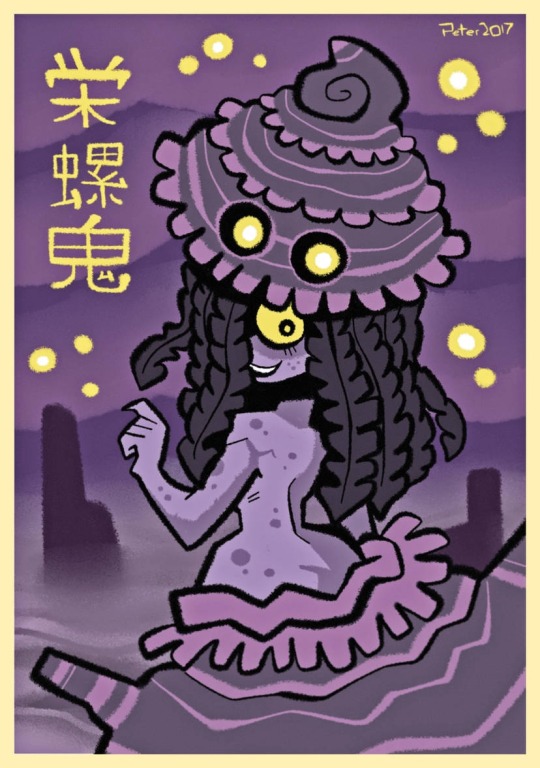
Generally speaking, the 18th century yokai bestiaries by Toriyama Sekien are some of the best sources out there if you want to know more about creatures from Japanese folklore.
With this fourth instalment in Sekien’s yokai encyclopaedias, however, he took a lot of liberties. Instead of illustrating monsters from well-known folktales and legends, he wrote a narrative in which he fell asleep and saw hordes of strange monsters in his dreams, many of which he invented himself. Among the creatures he supposedly dreamt up was the Sazae-Oni, a sea demon with a horned turban shell for a head (these snails are called ‘sazae’ in Japan, hence the name). He referenced an old wives’ tale that sparrows supposedly dive into the sea and transform into clams to hibernate during the winter, and a saying ‘moles emerging as quails’ which refers to the emergence of hibernating animals in spring. If these animals can transform into other animals (not intended literally), why couldn’t the power of nature turn a snail into a demon?
In this book, the fiend is depicted as a vaguely humanoid monster with a long, snail-like body coming out of a snail’s shell. Its head is a shell with eyes and strands of seaweed. Though Sekien did not invent the Sazae-Oni – the aforementioned folktales apparently predate him – his shell-tailed depiction of the monster became a mainstay in Japanese culture, with numerous appearances in tv shows, manga and other media. In particular, I think the Pokémon Slowbro and the Digimon Shellmon are based on this yokai.
Sources:
Yoda, H. and Alt, M., 2016, Japandemonium Illustrated: the Yokai Encyclopedias of Toriyama sekien, 319 pp., p. 256. This work is a translation of the Gazu Hyakki Yagyo tetralogy by Toriyama Sekien in the 18th century.
Papp, Z., 2010, Anime and Its Roots in Early Japanese Monster Art, Global Oriental, 194 pp., p. 95.
(image source 1: Shigeru Mizuki, illustration based on Toriyama Sekien)
(image source 2: BillSpooks on Deviantart)
#Yokai#Japanese mythology#Aquatic creatures#Shapeshifters#Mythical creatures#mythology#folklore#I find it really interesting that the demon is a clear antagonist in the first story#But in the second tale she punishes the evildoers
43 notes
·
View notes
Note
A Situation For Male Hashiras Where The S/O Is The Father Figure Of The Hashiras And Is Around 70-85 Years Old And During An Oni Attack The S/O Is Affected By A Kekkijutsu Which Rejuvenates Him Back Into The Body Of An 22 year old male.
Would Hashiras Feel Intimidated Seeing How Attractive and Handsome Their Father Is? Like prettier than them?
How would Tengen feel about his three wives paying a lot of attention to him due to his beautiful face and body?
Would Obanai feel intimidated due to Mitsuri appearing to like the S/O a lot in that younger appearance? Considering that the S/O is very Attractive.

Demon slayer masterlist
✿✼:*゚:.。..。.:*・゚゚・**・゚゚・*:.。..。.:*゚:*:✼✿
An: for some fathers I go with their occupation from other fics.
Mitsuri's ff is a Baker.
Giyuu and Rengoku's is a retired hashira.
Shinobu's is a doctor.
Obanai, muichirou, sanemi and tengen are people from their past.
Demon slayer masterlist
-------
Rengoku
Everyone was stunned except for shinjuro
Shinjuro looked at you like
Kyojuro complimented you on your physique and encouraged you to become a slayer again
That was quickly shot down by shinjuro saying that even if you were young again you haven't fought in years and you could do something else with you time
Senjuro is just glad your alright, he was so worried when he heard you were attacked
Tengen
You went out for a walk when you were attacked
When you got back Hina greeted you thinking you were there to visit uzui
He wasn't there at the moment so Makio and Suma kept you busy while Hina made snacks
You tried to explain who you were by saying you name and what happened but they didn't get it
I guess they thought you weren't right in the head or something
"Oh our father in law has the same name" -Suma
When Tengen came back he recognized you immediately
He explained everything again and they realized you weren't crazy and were actually their FIL
They gushed over you for the rest of the day
Tengen was jealously sitting in the corner while watching
Obanai
He's glad that your young again
to him it means more years with a father figure
He made sure you never left his sight
You were once a fragile old man after all
You and obanai were going out to eat when you ran into mitsuri
"HI OBANAI" -mitsuri yelled from afar catching your attention
"Hello Kanroji" the both of you said
She looked at you confused but still smiled
"Hello I don't think we've met. I'm mitsuri Kanroji."
"Kanroji it's me, Y/n"
She looked so confused until obanai explained
"You look amazing, Mr. L/n" -Mitsuri
That comment set obanai off
He looked at you like you had lost his trust for days
Sanemi
It was foolish for you to go on a mission with him but u went anyway
He was fighting
"WTF HAPPENED I LOOKED AWAY FOR A SECOND!"
He still treated you like you were old
He wouldn't let you walk for too long
He would do all the chores
He would chase Genya away for bothering you while you were resting your eyes
He would watch you sleep to make sure you weren't dead (ya know how old look dead when they sleep)
Genya would be confused but not ask about it and instead do more active things with like (like some things that gyomei taught him)
Muichiro
he doesn't know who tf you are
One minute your old and the next your young
"Tokito it's me"
"Who?"
"Y/n"
.
.
.
"No your not"
He refused to leave the area without you
It took a message, by crow, to shinobu to prove to him that you were you
For days be was awkward around you
He would stare as if he's solving math problems in his head
Giyuu
Initially he was scared cause you just fought off a demon at your old age but when he got to look he you he was just confused
How could you be young again
The both of you went to visit Urokodaki and he had a good laugh at the situation
Giyuu didn't think it was funny
He was genuinely concerned
He took you to shinobu but she said everything was fine
That didn't help ease his worries tho
He watched over you like a hawk
He went on missions less and instead watched over you
No matter how many time you tell him your fine he just can't take your word for it
Shinobu
she'd do multiple check-ups out of confusion
How is it possible that your young again
Was it just your appearance that changed or your body too?
Is it permanent?
The triplets help shinobu while trying not to stare at you they look away when you catching them
Kanao just stares
Aoi acted as if nothing happened, she never treated you differently and even snuck your favorite food to you when Shinobu wasn't looking
Mitsuri
She got a message from her crow that your shop was under attack
She was panicking as she raced to get to you but when she got there, in your place behind the counter there was a attractive young man
This made her more scared she thought 'you' were your relative or something
When you told her what happened she dropped her sword and hugged you
Say goodbye to your newly young bones cause the hug she gave you will made you feel old again
"I'm sorry but I thought you were dead."
✿✼:*゚:.。..。.:*・゚゚・**・゚゚・*:.。..。.:*゚:*:✼✿
#male reader#demon slayer x reader#kny x reader#rengoku x reader#tengen x reader#tengen x wives x reader#obani x reader#sanemi x reader#muichirou x reader#giyuu x reader#shinobu x reader#mitsuri x reader#reticent writes#reticent writer
387 notes
·
View notes
Text
Demon king, demigod, drunkard, dōji: exploring the archetypal oni, from Ōeyama to Lotus Eaters
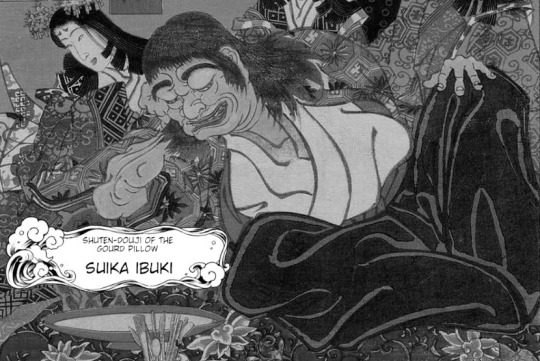
By popular demand, I wrote an article covering the background of Shuten Dōji and his underlings, and how it influenced Suika’s character and the idea of the Four Devas of the Mountain in Touhou. It was initially scheduled for last month, but I’ve experienced unplanned delays. Read on to learn if you want to learn what Suika has to do with Yamata no Orochi and Mara, if it’s true that oni never lie, and more. I will also explain why making your own fourth Deva of the Mountain is entirely fair game and anyone telling you otherwise is wrong about the source material which inspired ZUN. The article contains some spoilers for WaHH and a number of other Touhou installments, so proceed with caution if that might be an issue for you.
Ōeyama, or Shuten Dōji: origins
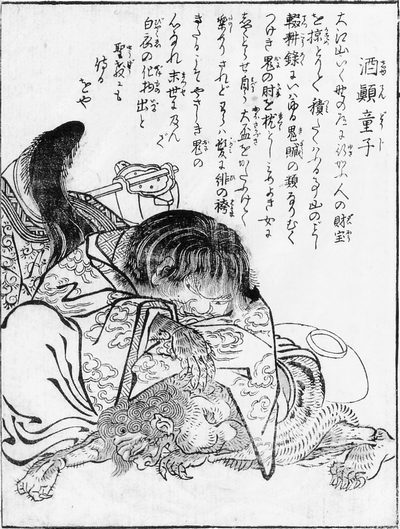
Shuten Dōji, as depicted by Sekien Toriyama in Konjaku Gazu Zoku Hyakki (wikimedia commons)
It perhaps seems a bit silly to start this article with an inquiry into the identity of Shuten Dōji (酒呑童子, “wine-loving youth” or something along these lines). After all, while Touhou characters are often based on obscure figures, Suika is hardly an example of that category. Shuten Dōji is arguably THE archetypal oni, known even to people with limited familiarity with Japanese mythology and folklore. And yet, the matter is nowhere near as clear cut as it might seem at first glance. From a certain point of view, Shuten Dōji might not even exactly be an oni, strictly speaking. A book from Nara simply titled Ōeyama ("Mt. Ōe") offers a detailed account of Shuten Dōji’s origin. His father was not a man or a demon, but rather a mountain god, Ibuki Daimyōjin (伊吹大明神). That’s not all, though - according to a local belief, Ibuki Daimyōjin was actually Yamata no Orochi. How does that even work? Contrary to the more widespread tradition, the inhabitants of the area around Mt. Ibuki from the Muromachi period onward believed that Orochi survived his confrontation with Susanoo and hid in the mountains. That’s actually not even the most unusual variant tradition about Orochi. A widespread belief through the middle ages was that he eventually managed to redeem himself, becoming a divine dragon (shinryū, 神龍) residing in the dragon palace under the sea. In that capacity, he was sometimes associated with emperor Antoku, with the latter even claimed to be his reincarnation, for example in a local legend associated with the Atsuta Shrine, preserved in the noh play Kusanagi. In esoteric Buddhist doctrine Orochi was sometimes perceived as a local manifestation (suijaku) of the buddha Yakushi - much like Susanoo was. Ichijō Kaneyoshi in his Nihon shoki sanso (1455–1457) went into yet another direction, presenting the snake as identical with the naga girl from the Lotus Sutra. Apparently, he specifically means the version of her from Shaku Nihongi… who is identified there as Susanoo’s wife, down to being equated with Kushinadahime (this was not unusual in itself - Susanoo was equated with Gozu Tennō based on similar character, so it was sensible for their wives to be seen as analogous). This effectively created a scenario where Susanoo married his nemesis.

A Japanese depiction of the naga girl offering a jewel to the Buddha, as described in the Lotus Sutra (wikimedia commons)
Anyway, back to Shuten Dōji. According to Ōeyama, Ibuki Daimyōjin, before he even came to be known under this name, fell in love with the daughter of a local feudal lord, Sugawa. He started visiting her at night and she as a result eventually became pregnant. The identity of the visitor was unknown to her father, and out of frustration and fear that nefarious supernatural forces might be involved he eventually contacted various religious officials to perform exorcisms. Needless to say, Ibuki Daimyōjin was less than thrilled, and decided to display his divine wrath through rather conventional means: Sugawa was struck by illness. He once again summoned various Buddhist monks and onmyoji, this time to attempt to heal him. They concluded that the disease will disappear if the deity who caused it is properly honored, and established formal worship of Ibuki Daimyōjin, which apparently did indeed help. Sugawa’s daughter eventually gave birth to Ibuki Daimyōjin’s child. The child started to cause problems at the age of three: his love of alcohol manifested for the first time, earning him the moniker of Shuten Dōji. By the time he was ten, his misdeeds were too much for his family to bear with and his grandfather decided to send him to Mt. Hiei to become a novice (chigo). The monastic lifestyle didn’t really change much though, and Shuten Dōji continued to drink. Eventually he managed to convince three thousand monks (sic) to drink with him and to join him in an “oni dance” during which everyone put on masks representing demons. The festivities lasted seven days. When Shuten Dōji woke up afterwards, he realized his mask had fused with his face, and he was no longer able to take it off. The other participants fled out of fear of his new form.
Shuten Dōji’s Mt. Hiei career was subsequently cut short by Saichō, the founder of the Tendai school of Buddhism. After learning what happened, he prayed to the buddha Yakushi and to Mt. Hiei’s protective deity Sannō Gongen to banish Shuten Dōji. It's worth pointing out that presenting young Shuten Dōji and Saichō as contemporaries is basically standard, and pops up in multiple legends. There are variants where Kūkai, the founder of Shingon, plays a similar role instead, to. They actually lived some 200 years before the other historical figures who appear in Shuten Dōji narratives, but this is not an oversight. It is a given that a partially divine being would live for much longer than a human.

A Heian period portrait of Saichō (wikimedia commons) As a result of Saichō’s success, Shuten Dōji had to flee. He tried to return to his grandfather’s residence, but this was no longer an option for him. He temporarily hid on Mt. Ibuki, but eventually left for Mt. Ōe, where he finally became a veritable "demon king".
The reason why Shuten Dōji was rejected by his family is that he was recognized as an “oni child” (鬼子, onigo). In the folkloric sense, this term refers to supernatural beings which are nonetheless partially human by birth. Not necessarily part oni, though. Another well known onigo, Sakata no Kintoki, was the son of a yamauba, for instance. However, Yanagita Kunio noted that this term also referred to children born with teeth (a real, though very uncommon phenomenon), who were believed to turn into oni - much like how Shuten Dōji did. He states that especially before the Edo period this lead to cases of child abuse or outright murder. In some cases sending the child to become a member of Buddhist clergy was seen as a remedy. For example, a twelfth century monk named Jōjin in a letter relays that he suggested this to the mother of such a newborn. It is not hard to see that Ōeyama likely consciously references this custom.
The other origin of Shuten Dōji
Yet another tradition is preserved in a variant of the standard Shuten Dōji tale which switches the location of his demise from Mt. Ōe to Mt. Ibuki: here Shuten Dōji is not just any demon, but a manifestation of Mara. As in, the opponent of the Buddha and demon king of the sixth heaven, not some other accidentally similarly named figure.
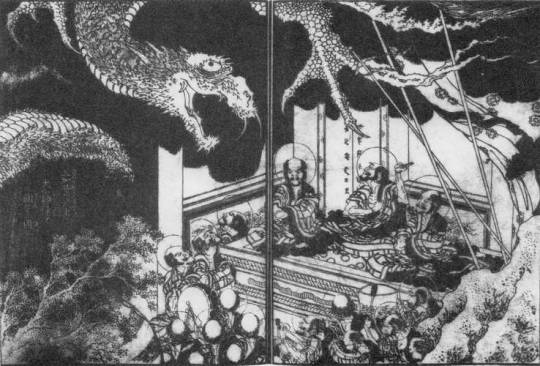
Mara, as depicted by Hokusai in Shaka-goichidai-zue (wikimedia commons)
It is presumed that this portrayal of Shuten Dōji might be tied to medieval Japanese traditions pertaining to Mara. They might sound unusual today: he was both a “demon king” (魔王) obstructing enlightenment, as expected, but also a jinushi (地主), or “landholder deity”. From the Buddhist point of view, jinushi were ambivalent figures: on one hand, their presence was responsible for bestowing specific locations with holiness. On the other hand, they could resist Buddhism as demonic forces, and had to be subjugated or converted to prevent that. Mara was the ultimate jinushi, the king of the world as a whole. A role already attributed to him in earlier Buddhist sources was basically adjusted for this framework. The jinushi version of Mara originated among proponents of the imperial court and mainstream Buddhist institutions, but it curiously also gained traction among the opponents of these structures. Mara became somewhat of an anti-establishment icon more than once, essentially. A legend links him with (in)famous rebel Taira no Masakado (who you may know from SMT) for this reason.
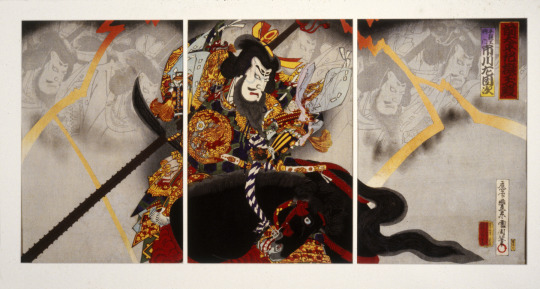
Masakado, as depicted by Kunichika Toyohara in Sen Taiheiki Gigokuden (wikimedia commons)
Other similar examples are also known. A local legendary figure from the Tsugaru peninsula in modern Aomori prefecture, Tsugaru Andō (津軽安藤), who after a failed rebellion fled to Hokkaido, was proudly described as a vassal of Mara by local officials who claimed descent from him. Prince Sutoku, a banished opponent of emperor Go-Shirakawa, swore a vow to become like Mara. Oda Nobunaga famously referring to himself as the “demon king of the sixth heaven” in a letter to Takeda Shingen is likely another example. Reportedly a related belief that praying to the jinushi version of Mara can spare one from conscription persisted as late as the early 20th century, though generally he belongs to the realm of “medieval myths” which faded with the ascent of a new system of values in the Meiji period, in which the early imperial chronicles were favored. Even though it is largely forgotten today outside of specialized scholarship, there is much more to this Mara tradition. It led to the development of one of my favorite Japanese myths with no popcultural reception, but you will have no wait a few more weeks to learn more. It has been argued that behind the identification of Shuten Dōji and Mara might reflect a historical event of the sort which led to associating the latter with figures such as Masakado. In other words, that Shuten Dōji in this case might be less a demon and more a demonized form of some opponent of imperial or religious authorities.
It has been argued that the Ibuki version was the result of combining an original oral narrative, a precursor of the textual versions we are familiar with today, with the memory of the death of a certain Kashiwabara Yasaburō, a bandit leader, in 1201. It has in fact been argued that even the mt. Ōe version might simply be a particularly fabulous reinterpretation of a punitive mission against bandits robbing and murdering travelers. Such rationalist explanations are not exactly new - Ekken Kaibara already argued in the Edo period that the legend of Shuten Dōji must have been the reflection of the downfall of a real bandit who perhaps wore the mask of an oni while committing robberies.
It’s important to bear in mind to not go overboard with this speculation, though. Ultimately the Mt. Ibuki version has a more pronounced religious character than other variants in general: Shuten Dōji’s nemesis Raikō’s is identified as a manifestation Bishamonten or Daiitoku Myōō (in the latter case, Bishamonten and the three other heavenly kings correspond to his four retainers), emperor Ichijō with Miroku (Maitreya), and Abe no Seimei, who plays a minor role in vanquishing the demon, with Kannon. These equations reflect the idea of honji, or “true nature” of Buddhist figures, who were believed to take various guises through history to help people reach nirvana, for example these of local deities or historical figures. The best known example of application of this doctrine in Japanese Buddhism is obviously the historical phenomenon of honji suijaku, which was focused specifically on kami.
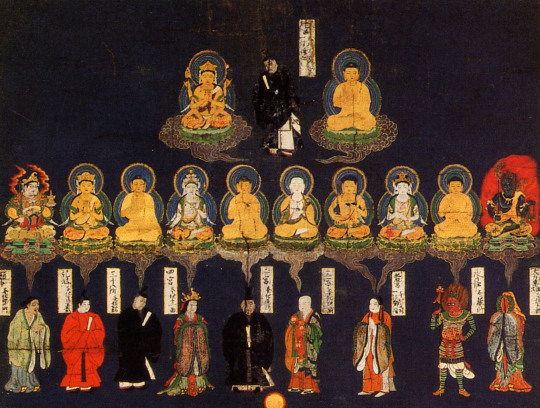
A Kasuga mandala representing the correspondences between Buddhist figures and local kami (source; reproduced here for educational purposes only)
The legend of Shuten Dōji
Regardless of which mountain is identified as the residence of oni, and of whether the dramatis personae are identified with Buddhist figures or not, the plot of the various versions of the legend of Shuten Dōji surprisingly does not vary all that much. While it is reasonably well known, I figured it won’t hurt to summarize it here anyway, especially since the information above should make it possible to view it from many new angles.
The oldest surviving version, Ōeyama Ekotoba (“Illustrations and Writing of Mt. Ōe”), presumably based on preexisting oral sources, comes from the fourteenth century, specifically from the Nanbokuchō period. However, the story only reached the peak of its popularity a few centuries later, in the Edo period. This was a part of a broader phenomenon: preexisting tales about warriors matched the sensibilities of the new ruling classes and were kept in circulation by them, but eventually they also became a part of urban popular culture. Many adaptations were produced, including noh plays and ukiyo-e. To put it very colloquially, the heroic warriors and demon quellers from the previous periods became the Edo period counterpart of contemporary superhero media. This is a genuine comparison employed in scholars, for clarity, not a joke. As remarked by Bernard Faure, the most widespread version is basically framed as if it was a tabloid story from the Heian period. In 995, young women (and in some versions men too) disappear whenever a particularly violent storm occurs, and nobody knows how to stop it. Not even the power of Buddhist exorcisms is enough. Seeing as in the portrayed time period that was pretty much the universal solution to supernatural problems, this is a big deal.
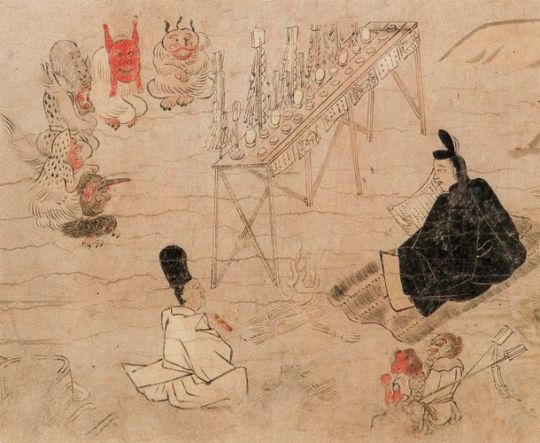
Abe no Seimei (right) in the Fudo Rieki Engi (wikimedia commons) This is a source of distress for a certain official, Ikeda Kunikata (or, in some version, Kunitaka), whose only daughter is among the kidnapped women. He decides to seek the help of the Heian period superstar Abe no Seimei, arguably the most famous onmyoji in history. Alternatively, the expert contacted is a certain Muraoka no Masatoki, who to my best knowledge is a fictional character and doesn’t appear anywhere outside of some variants of this tale. Either way, thanks to this intervention it is possible to identify the culprit as a demonic being residing on Mt. Ōe (or alternatively on Mt. Ibuki). In one of the versions featuring Seimei he specifically identifies him as a tenma (天魔), “heavenly demon” - a term commonly used to refer to tengu (as ZUN does in Touhou) and to servants of Mara (overlapping if not identical categories, really; stay tuned for a future article exploring this). However, onmyoji arts are not enough to stop the crisis; all Seimei can guarantee is that Kunikata’s daughter will survive, but he has no way to confront the demon directly. Kunikata therefore decides to bring the case to the attention of the emperor, Ichijō. He holds a meeting with various ministers, who note that in the past a similar case was solved by Kūkai (recall his already mentioned association with Shuten Dōji). However, there are no monks of equal skill left, so his feat cannot be repeated.
It is then concluded that the only way to end the demon’s reign of terror it is to send the strongest warrior they were aware of, Minamoto no Yorimitsu (Raikō) and his four retainers, Watanabe no Tsuna, Sakata no Kintoki, Taira no Suetake, and Tairi no Sadamitsu, on a mission to kill him. Raikō is also assisted by Fujiwara no Yasumasa (Hōshō) and his anonymous attendant, but these two never gained much prominence as characters in this narrative. Additionally, in some versions other figures from the same period - Taira no Muneyori, Minamoto no Yorinobu (Raikō’s younger brother) and Taira no Korehira - are namedropped as potential candidates considered by the emperor, but they all reportedly decline to partake out of fear.
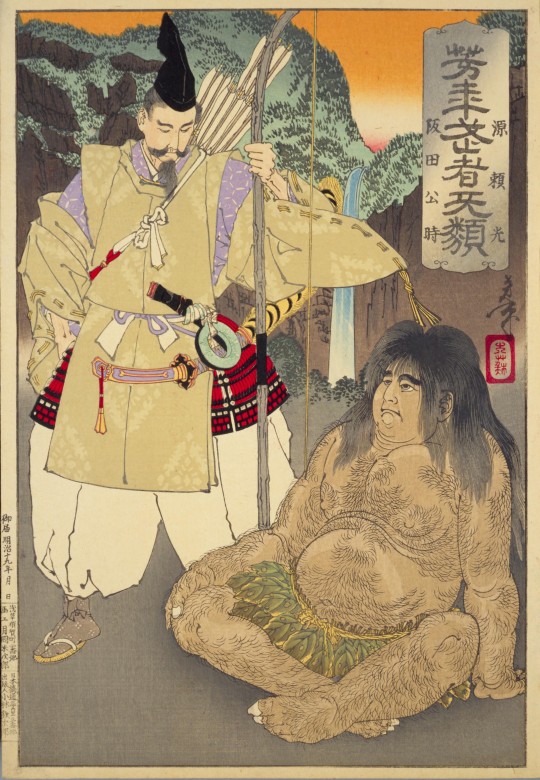
Raikō and Kintoki, as depicted by Yoshitoshi Tsukioka (wikimedia commons)
Preparations started with prayers in Sumiyoshi, Kumano, Kasuga and, in some versions, Hie shrines. They did not go unanswered. Raikō and his retainers subsequently encounter a group of shugenja (mountain ascetics) who turn out to be the manifestations of the deities they paid honor to: Sumiyoshi Myōjin, Kumano Nachi Gongen, Hachiman (here addressed as a bodhisattva) and, if the Hie shrine is included in a given version, Sannō Gongen. They explained that to safely enter the fortress of Shuten Dōji, Raikō and his men must disguise themselves as shugenja (that’s because the legendary first shugenja, En no Gyōja, famously had an entourage of demons). They also provide him with supernatural wine. They state the oni will inevitably drink it due to their fondness of alcohol, only to end up poisoned as a result. In some versions they vanish afterwards, but in others they continue to accompany Raikō. The protagonists then encounter a woman washing blood stained clothes. In some versions she is described as elderly, and states she has lived for 200 years as a servant of Shuten Dōji. In the most widespread Edo period version, she is young and says she was only kidnapped a year earlier, though.
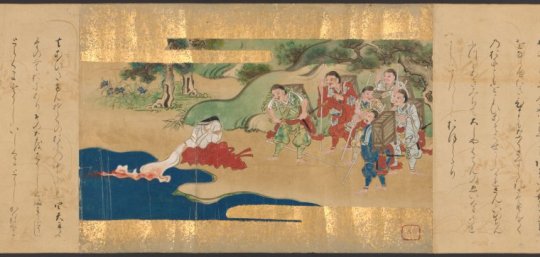
Encounter with the woman washing bloody clothes (NYPL Digital Collections) Regardless of her age, she reveals some additional information about Shuten Dōji, though that also varies depending on the version. In some, she explains that he looks like a human during the day, but takes the form of an oni at night. His human form is specifically that of a dōji, literally “child”, but we’ll get back to the full context of this term later. In any case, I think it's safe to say the shape and size changing is where Suika'a ability came from. In another variant, the woman warns the heroes that Shuten Dōji is enraged by Abe no Seimei’s actions, as the onymoji apparently figured out in the meanwhile how to keep the people of Kyoto safe by employing a number of shikigami (a standard part of his repertoire). There are no further stops on the journey, and shortly after the encounter with the woman of variable age Raikō and his men enter the mountainous land of the oni. Especially in the older versions, it’s a place completely out of this world, with all four seasons occurring at once. Once they enter the fortress located there, they instantly encounter Shuten Dōji… and ask him for a place to stay for the night.

Distinctly human-like Shuten Dōji, as depicted by Yoshitoshi Tsukioka in One Hundred Ghost Stories from China and Japan (LACMA; reproduced here for educational purposes only)
Rather unexpectedly, he instantly agrees. He then tells them about his past; this largely a shorter version of the legend already discussed earlier, though with nothing predating the Mt. Hiei section mentioned. We also get a specific date for his arrival on Mt. Ōe, 849. This doesn’t last long, though, and soon he invites the protagonists to partake in a feast with him. This is obviously not a regular party, and while the individual versions can be more or less graphic, it is clear that the oni are consuing the flesh and blood of their captives. Despite various horrific sights, Raikō maintains composure. He uses the opportunity the feast presents him with to offer Shuten Dōji the sake he received from the three (or four) deities earlier. As expected, Shuten Dōji gets drunk, and leaves to rest in his chamber.
The other oni continue to party. In some versions, some of them try to approach the protagonists by disguising themselves either as a group of courtly ladies or as a dengaku troupe, but Raikō’s glare is so intense they quickly relent. Eventually all of the oni give up on attempting to engage with the alleged ascetics and end up drunk. That’s when the heroes decide to free their captives. These obviously include the women from Kyoto. However, as it turns out, Shuten Dōji’s rampages actually extended beyond Japan, to India and China, though only captives from the latter area actually appear. Multiple versions additionally mention that one of the prisoners was a young acolyte of the Tendai abbot Ryōgen, who was protected by assorted deities. This doesn’t really come into play in any meaningful way, though. Once everyone is freed, the heroes draw their weapons and enter Shuten Dōji’s chamber.
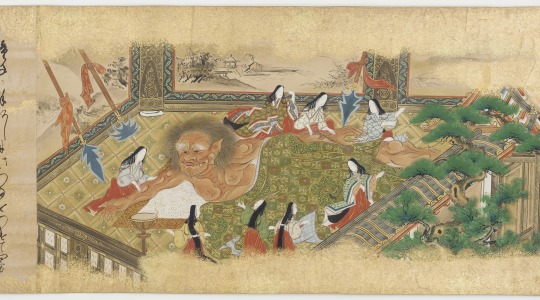
Sleeping Shuten Dōji (National Museum of Asian Art; reproduced here for educational purposes only)
The protagonists finally witness Shuten Dōji's oni form. He is five jō (around fifteen meters) tall, has fifteen eyes and five horns. His head and torso are red, his right arm is yellow, his left arm is blue, his right leg is white and his left leg is black. This might be a reference to the five elements. Alternatively, he could be described as entirely red, which might either be yet another way to reference his love of alcohol, as in the case of the shōjō, or an indication he was comparable to a “plague deity” (疫神, ekijin). The manifestations of the deities from earlier show up again, this time to hold Shuten Dōji in place so that Raikō can strike. He cuts off his head, but to his shock it rises into the air and starts talking.
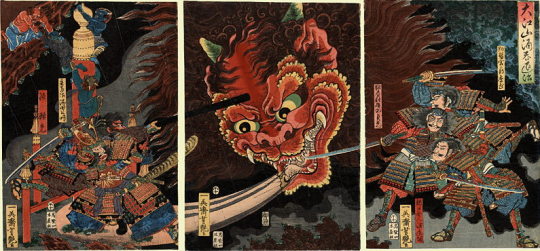
Confrontation between the heroes and the floating head of , as depicted by Yoshitsuya Utagawa (wikimedia commons)
Shuten Dōji actually mocks the heroes: “How sad, you priests! You said you do not lie. There is nothing false in the words of demons.” Needless to say, his final words are pretty directly referenced in Touhou. Oni, at the very least, claim they do not lie. Mileage of course varies, though. ZUN is not the only author drawn to this element of the legend. It would appear that even the Japan Oni Cultural Museum has advertised itself with the words “there is nothing false in the words of demons” in the past. As noted by Noriko T. Reider, emphasizing this apparent honesty (or naivete) sometimes serves as a way to make oni sympathetic or even relatable for modern audiences. However, it's worth noting that in the noh version, Raikō pushes back against Shuten Dōji’s words, and points out even the claim oni do not lie is a lie. He has a point, considering some versions outright establish oni capture their victims by disguising themselves as people close to them, imitating their voices. It probably also should be pointed out that in Konjaku Monogatari, oni are said to be scary precisely because they can tell apart right and wrong.
Anyway, oni ethics aside, it turns out that to kill Shuten Dōji for good, one has to gouge out his eyes. Once that is accomplished, Raikō's mission is finally complete. After killing the other oni, the protagonists take the head with them to Kyoto. Obviously, they also take the freed captives with them. The young women return to their families, and the Chinese men head for the coast to find a ship which could take them home. They promise to let the emperor (the Chinese one, for clarity; that would be Zhenzong of Song in 995) about Raikō's heroism. In the versions where the woman washing clothes was elderly, rather than simply one of the young captives, on the way back the protagonists learn that she has passed away in the meanwhile, since her lifespan was unnaturally extended by Shuten Dōji. Once he died, so did she.
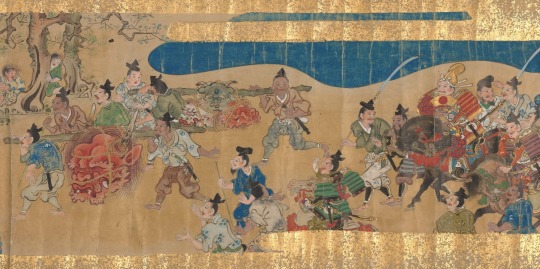
Transport of Shuten Dōji's head to Kyoto (NYPL Digital Collections)
Before the head can enter the capital, a purification ritual has been performed. Abe no Seimei thankfully knows how to do that. Thanks to him, all the relevant authorities can examine it. The emperor decides it will be best to store it in the treasure house of Uji. This location pops up in multiple legends. The severed heads of the two other equally famous malign entities, Ōtakemaru and Tamamo no Mae, were also stored there according to legends focused on them, in addition to various Buddhist relics and mundane treasures. In an alternate version, the head never reaches the imperial court. Raikō and his retainers encounter the bodhisattva Jizou, who tells them it is too impure to be shown to the emperor, and suggests burying it. The location selected, a hill on the northwestern limits of the city, came to be known as Kubizuka (首塚), literally “head tumulus”. Shuten Dōji actually came to be enshrined there as Kubizuka Daimyōjin (首塚大明神), and in this divine guise developed an association with learning and ailments of the head.
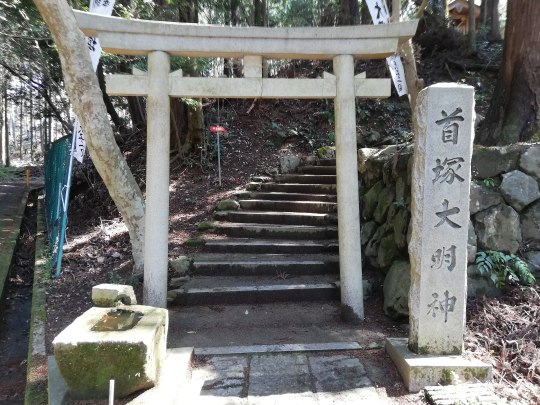
The Kubizuka shrine in 2019 (wikimedia commons)
There is yet another variant tradition about the final fate of Shuten Dōji: after his death he became a vengeful spirit, and then turned into a tsuchigumo, just to be defeated by Raikō and his retainer Tsuna for a second time.
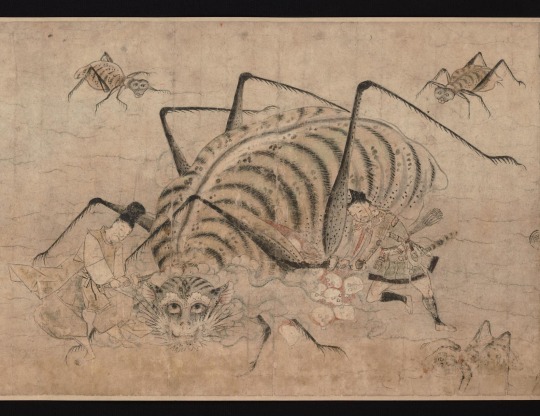
Raikō and Tsuna battling tsuchigumo, as depicted in Tsuchigumo no Sōshi Emaki (wikimedia commons)
Interestingly, it has been argued the tale of Shuten Dōji was at least in part based on that of the tsuchigumo Kugamimi no Mikasa (陸耳御笠), who resided on Mt. Ōe according to Tango Fudoki Zanketsu (丹後風土記残欠). The tale is not preserved fully, though, so all we know for sure other than the location is that the hero opposing him was Hikoimasu no Miko (日子坐王), a stepbrother of emperor Sujin (he is also attested in other sources). A second tsuchigumo, Hikime (匹女) is successfully defeated, but the fate of Mikasa is left unspecified in the surviving sections. This obviously makes further comparisons difficult. The topic of tsuchigumo cannot be dealt with here due to space constraints, but I promise I will return to it in a future article.
The supporting cast of Shuten Dōji
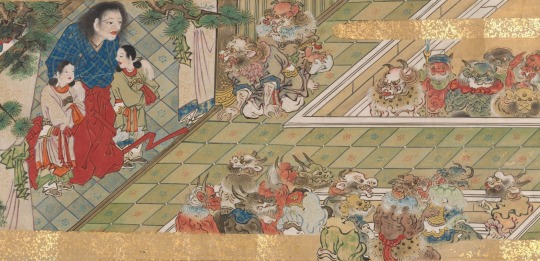
Shuten Dōji in his human form and his oni henchmen (NYPL Digital Collections)
Something that requires further discussion is the matter of the underlings of Shuten Dōji, since it is a topic directly relevant to Touhou. You might have noticed I actually avoided referencing them in any meaningful capacity in the summary of the legend. That’s because they actually do not play a major role. There also wasn’t any consistent view regarding their number or names. However, the version which came to be standard in the Edo period lists four of them - an obvious mirror of Raikō and his entourage. As a matter of fact, both groups even share the same moniker, Four Heavenly Kings.
This idea predates the Edo period, though. An earlier variant based on picture scrolls created by Kanō Motonobu already lists four servants of Shuten Dōji: Gogō, Kiriō, Ahō, and Rasetsu (yes, an oni named Rakshasa). However, two additional oni at his service are also listed, Kanakuma Dōji and Ishikuma Dōji. They are described as his personal guards, and as, well, dōji. It is clear the term is used in a literal sense here - they are said to look like “overgrown adolescents”. Two different subordinates are mentioned in another picture scroll: Kirinmugoku (麒麟無極) and Jakengokudai (邪見極大). However, they do not receive any characterization, or even physically appear in the narrative. Shuten Dōji shouts their names when he is about to die, and the very assumption that he’s referring to his oni subordinates is conjectural. The same version states that there were at least ten oni in the fortress so it’s not like it’s an implausible assumption.
The group of four oni returns in the standard Edo period version, where their names are Hoshikuma (“Star-bear”) Dōji, Kuma (“Bear”) Dōji, Torakuma (“Tiger-bear”) Dōji and Kane (“Iron”) Dōji. There’s also a fifth oni who is not a member of the group of 4, but shares the same naming pattern, Ishikuma Dōji. He actually gets a handful of lines, though they do not really provide him with much of a character beyond establishing he likes sake, that he eats humans, and that he is loyal to Shuten Dōji. Kane Dōji also gets a single line… explicitly alongside Ishikuma and multiple other nameless oni, though, and it boils down to announcing they will go down fighting because without their leader they no longer have a place to go.
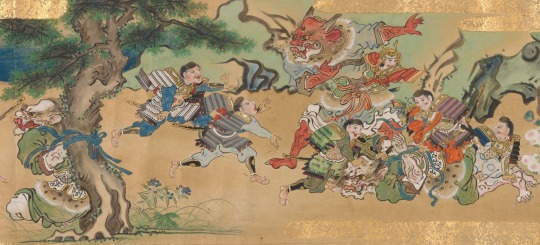
Defeat of the oni (NYPL Digital Collections)
Ibaraki Dōji: Shuten Dōji’s only equal?
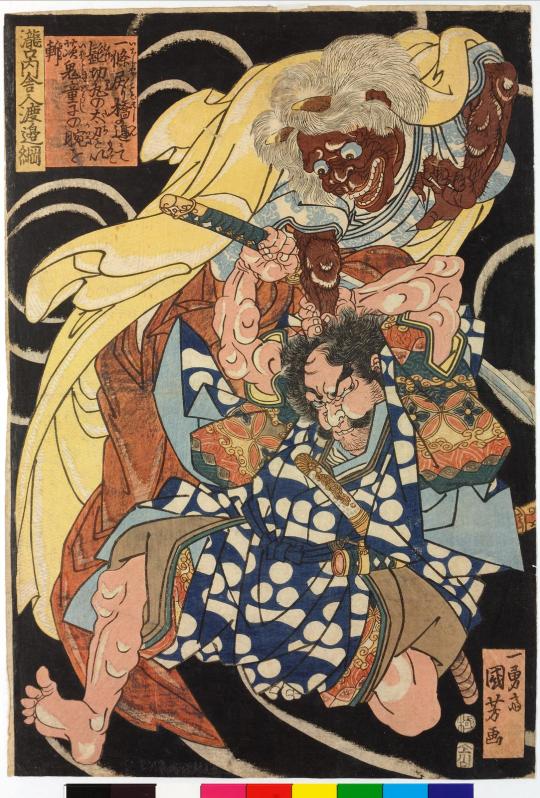
Watanabe no Tsuna battling Ibaraki Dōji (wikimedia commons)
A further unique case is that of Ibaraki Dōji, who actually acquired some fame as an individual character, and today is sometimes cited as an example of an oni equally archetypal as Shuten Dōji. Despite being portrayed as a close associate of Shuten Dōji, Ibaraki Dōji to my best knowledge isn’t counted among the Four Heavenly Kings in any version. The character of the connection is evidently more nebulous. I know an assertion that a tradition presenting Ibaraki Dōji as Shuten Dōji’s wife is attested is repeated as fact on wikipedia and various at least semi-credible websites, but there is never a citation provided, and no version of the narrative covered in articles and monographs I have access to includes such an element. I am not claiming it is impossible, though I do feel the fact it doesn’t come up in any paper or monograph discussing either figure I have access to doesn’t mention to might indicate it’s either a recent reinterpretation or a very obscure local variant. Note this is not meant to be an argument against any Touhou ships. What I can say with certainty is that Ibaraki Dōji’s gender is actually a matter of occasional academic dispute. In the versions of the basic Shuten Dōji narrative which mention this oni, he is pretty firmly male. However, he is said to be capable of taking the form of a woman. Noriko T. Reider argues that on this basis it can be effectively assumed that at the very least this specific oni can be considered genderless or capable of freely changing their gender, though she tentatively extrapolates this ability to oni in general. While Ibaraki Dōji’s gender changing adventure is technically its own legend, a reference to it was incorporated into the basic Edo period version of the Shuten Dōji narrative. During the feast, the latter mentions in passing that the former, his trusted ally, lost his arm in a fight with Watanabe no Tsuna during one of their Kyoto raids, after failing to abduct him while disguised as a woman. He clarifies that the arm was later recovered, but not particularly many details are provided. The rivalry between Tsuna and Ibaraki Dōji subsequently comes into play after Shuten Dōji’s death, when the protagonists are about to exterminate the other oni. Ibaraki charges him and they two fight without a clear winner for a while, until Raikō intervenes and kills the oni. I would argue that despite him being responsible for dealing the killing blow, it is Tsuna who should be considered Ibaraki’s nemesis, though. Interestingly, at some point ZUN considered featuring a character based on him in Wild and Horned Hermit (source). That obviously did not come to pass, though. Tsuna already fights an oni in Heike Tsuruginomaki, and many other variants of the story were written subsequently, with the noh play Rashōmon being the most famous. Curiously, the oldest version makes no reference to Shuten Dōji, and the oni actually resides on Mt. Atago, but by the Edo period the two were regarded as allies operating from Mt. Ōe. The details are otherwise generally similar across all of the sources. Raikō sends Tsuna on an errand. He encounters a woman on the Modoribashi Bridge in Kyoto, but as soon as he offers to take her with him she turns into an oni. Thinking quickly, he cuts off the creature’s arm, which is enough to make them flee. He keeps the severed limb as a trophy. Some time later, he is visited by an old woman who he assumes is his aunt... but who turns out to be the same oni, who uses a brief moment of confusion to recover the arm and fly away.
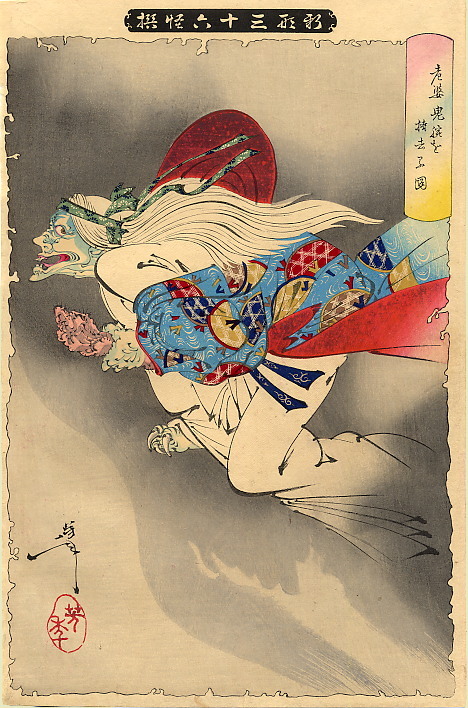
Transformed Ibaraki Dōji, as depicted by Tsukioka Yoshitoshi (wikimedia commons)
The legend of Ibaraki Dōji was evidently reasonably popular in the Edo period, and could even be utilized to comedic ends. One example is an Edo period satirical pamphlet, Thousand Arms of Goddess, Julienned: The Secret Recipe of Our Handmade Soup Stock, written by Shiba Zenkō and illustrated by Kitao Masanobu. Here the one-armed Ibaraki Dōji is one of the figures interested in leasing one of the now detached additional arms of the Thousand-Armed Kannon, who has apparently fallen in dire straits (“business slumps are inevitable, even for a Buddha”, comments the narrator, alluding to the financial conditions of the 1780s). As we learn, after making a purchase Ibaraki is disappointed by the lack of hair, and promptly hires a craftsman to add it:

Original translation by Adam L. Kern; reproduced here for educational purposes only. I am not responsible for the typesetting.
In my recent Ten Desires article I’ve already discussed the oni of Rashomon as a character in legends about Yoshika no Miyako, which I won’t repeat here. It will suffice to say that this conflation effectively made Ibaraki a penchant for poetry and fine arts, and that it indirectly put him in the proximity of the pursuit of immortality. Whether this is why ZUN made Ibaraki’s counterpart a wannabe immortal (“hermit”) is difficult to ascertain, but it does not strike me as impossible. The oni of Rashomon actually appears in at least one more legend which similarly portrays him as an enthusiast of the arts, though to my best knowledge this one never came to be reassigned to Ibaraki Dōji. It is centered on a famous biwa player, Minamoto no Hiromasa, who has to resolve the case of mysterious theft of an instrument from the imperial palace. As you can expect, it is revealed to specifically be an exceptional biwa, which bears the name Genjō. Hiromasa surveys the city in hopes of finding it, and eventually hears its distinct tones while passing near the Rashomon gate. He quickly realizes an oni is playing it. He politely asks if he can have it back, since it’s a treasure of the imperial court… and the oni eagerly obeys, thus bringing the story to a happy end. However, we are told Genjō acquired supernatural qualities in the aftermath of the theft, and only played when it felt like it, as if it was a living being. There is a variant which reveals that the oni of Rashomon was in fact the ghost of Genjō’s original maker, a craftsman from India. In this version, Abe no Seimei has to intervene to recover it, and the oni only agrees to return it after being promised a night with a woman he fell in love with who resembles his deceased wife. There is no happy ending here, though, as the woman’s brother convinces her she needs to kill the oni. She fails, and meets such a fate herself instead. It seems that the reader’s sympathy is actually supposed to be with the oni in this case.
Conclusions, or why you should make your own Deva of the Mountain
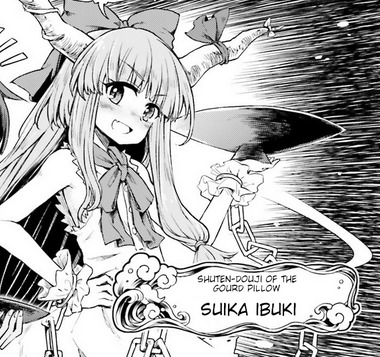
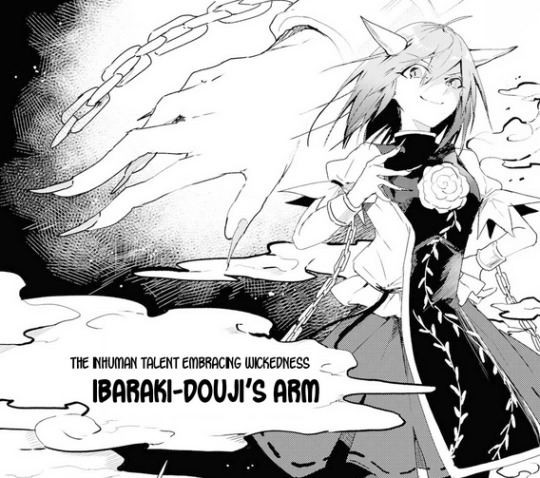
Obviously, there is nothing novel or clever about stating that the two figures this article is focused on, Shuten Dōji and Ibaraki Dōji, correspond to Suika and Kasen respectively. You can learn that from the official media itself, after all. Funnily enough, it seems this might have been even more blunt, judging from unused ideas for referencing the legend to an even greater degree in WaHH, with the defeat at Mt. Ōe as the explanation why oni reside… well, elsewhere (source). Granted, it would also be a disservice to ZUN to say he only created anime girl versions of the classic oni. He effectively created his own versions of both Shuten and Ibaraki - for every similarity between the irl background I’ve described and Touhou, there is also something brand new. That is part of what makes Touhou compelling, I would argue. Naturally, the fact that the group Kasen and Suika belong to is referred to as the Four Devas of the Mountain shows clear inspiration from the Edo period version of the original legends. However, Suika and Kasen are counted among the four, which is obviously an innovation. Additionally, while Yuugi is naturally named after Hoshikuma Dōji, who you were able to meet earlier, save for the name she is effectively a fully original character. Her ability references the Analects of Confucius, rather than anything directly tied to Shuten Dōji. And, on top of that in all honesty, she has more character than any of the additional oni appearing in the real legends. ZUN, as far as I am concerned, created a more than worthy addition to the classics. What about the much discussed fourth deva? I think it’s safe to say that in the light of the discussed material there simply isn’t a single most plausible option. As I stressed already, there’s no consistent group of oni appearing alongside Shuten Dōji, and it cannot be said that the Edo period version is clearly what should be treated as true in Touhou. ZUN picked what he liked from many versions. For what it’s worth, so far all of the oni forming the Four Devas are based on those who share the moniker of dōji, so that’s the closest we have to a theme. As I already said earlier, this term can be simply translated as “child” (or “lad”, though I think a gender neutral option is more apt since we are talking about Touhou here, ultimately). However, it has a more specific meaning when applied to supernatural beings. In this context it refers to a category of ambiguous figures characterized by “vitality, (...) hubris, and (...) unpredictability”, as well as fondness of violence, as summarized by Bernard Faure. Shuten Dōji, and by extension his underlings, are obviously the dōji par excellence. However, the term could also be applied to benevolent, or outright divine beings. That, however, goes beyond the scope of this article. I personally think despite the possible dōji theme the fourth slot will never be filled, ultimately. ZUN likes leaving gaps in established groups - there are types of tengu which were a part of the background for well over a decade, for instance. I think these are left as paths to make ocs with an instant excuse to interact with canon characters. Despite ZUN’s generally pro-fanwork stance I do not think I’ve ever seen anyone make this point. As far as I am concerned, the conclusion is clear: it’s entirely fair game to invent characters to fill the empty spot. There’s even a solid case to be made for reinventing oni from other legends as members of the Four Devas - remember that much of Ibaraki Dōji’s character was borrowed from a nameless oni from a legend about the Rashomon gate, as I discussed last month.
Bibliography
Bernard Faure, Rage and Ravage (Gods of Medieval Japan vol. 3)
Michael Daniel Foster, The Book of Yokai. Mysterious Creatures of Japanese Folklore
Adam L. Kern, Thousand Arms of Goddess, Julienned: The Secret Recipe of Our Handmade Soup Stock, written by Shiba Zenkō and illustrated by Kitao Masanobu (translation and commentary), in: An Edo Anthology: Literature from Japan’s Mega-City, 1750–1850
Keller Kimbrough and Haruo Shirane (eds.), Monsters, Animals, and Other Worlds. A Collection of Short Medieval Japanese Tales
Irene H. Lin, The Ideology of Imagination: The Tale of Shuten Dōji as a Kenmon Discourse
Michelle Osterfeld Li, Human of the Heart: Pitiful Oni in Medieval Japan in: The Ashgate Research Companion to Monsters and the Monstrous
Noriko T. Reider, Shuten Dōji: "Drunken Demon"
Idem, Japanese Demon Lore
Idem, Seven Demon Stories from Medieval Japan
also check out the scans of an amazing Shuten Dōji picture scroll from the NYPL collection here!
182 notes
·
View notes
Text

Jacob with Leah And Rachel
Artist: Andrea Appiani (Italian, 1754-1817)
Date: n. d.
Medium: Oil painting
Collection: Private collection
The Story of Jacob with Leah and Rachel
The complicated story of Jacob, Leah, and Rachel comprises one of the larger sections of Genesis and includes much information relevant to the history of the Jewish people. Jacob, the son of Isaac and grandson of Abraham, fled to his mother’s brother Laban. At the time, Jacob feared his twin brother, Esau, would kill him (Genesis 27:41–46). It was at Laban’s that Jacob met Leah and Rachel.
Laban offered his nephew Jacob a place to stay. Jacob soon fell in love with Laban’s younger daughter, Rachel, and agreed to work for Laban seven years in exchange for marriage to her (Genesis 29:16–20).
Laban agreed, but after seven years, he deceived Jacob. On the night that Jacob and Rachel were to be married, Laban gave Rachel’s older sister, Leah, to him as a wife instead. Jacob protested, but Laban argued that it wasn’t the custom to give the younger daughter in marriage first. So it was official: Jacob and Leah were to stay married. Laban then said Jacob could still have Rachel in exchange for another seven years of work (Genesis 29:21–30). In an ironic twist, the deceiver Jacob had himself been deceived. In exchange for fourteen years of labor, Jacob had two wives, Leah and Rachel.
Jacob showed favoritism to Rachael and loved her more than Leah. God compensated for the lack of love Leah received by enabling her to have children and closing Rachel’s womb for a time (Genesis 29:31). There developed an intense rivalry between the two wives. In fact, at one time the wives bartered over the right to sleep with Jacob. Genesis 30:16 says, “When Jacob came from the field in the evening, Leah went out to meet him and said, ‘You must come in to me, for I have hired you with my son’s mandrakes.’ So he lay with her that night,” and Leah became pregnant. In the end, Jacob fathered twelve sons and a daughter. Jacob and Leah had six sons and a daughter; Zilpah, Leah’s maidservant, bore Jacob two sons; Jacob and Rachel had two sons together; and Bilhah, Rachel’s maidservant, bore Jacob another two sons (Genesis 35:23–36).
After twenty years with Laban, Jacob and Leah and Rachel, now very wealthy, moved their family back to Canaan. As they were leaving Laban’s house, Rachel stole her father’s teraphim and lied about having them (Genesis 31). As he drew closer home, Jacob knew that he would have to face Esau again. He still feared Esau’s anger, and he sent gifts to satisfy him before he arrived. The night before Jacob crossed the Jabbok River, he “wrestled with God” and was given the name “Israel” along with God’s blessing.
The story of Jacob and Rachel ended tragically, as Rachel died giving birth to her second child, Benjamin. Rachel named him Ben-Oni (“son of my trouble”), but Jacob renamed him Benjamin (“son of my right hand”). Rachel “was buried on the way to Ephrath (that is, Bethlehem). Over her tomb Jacob set up a pillar, and to this day that pillar marks Rachel’s tomb” (Genesis 35:19–20).
Jacob and Leah’s marriage lasted longer, but eventually Leah, too, died in Canaan and was buried in the same tomb as Abraham and Sarah and Isaac and Rebekah (Genesis 49:30–32). Jacob and his son Joseph would later be buried in this tomb as well (Genesis 50).
The story of Jacob, Leah, and Rachel is filled with much difficulty, yet God used these people greatly to impact history. Their twelve sons were the leaders of the twelve tribes that became the nation of Israel. Through their family, God blessed the entire world, as Jesus Christ was born from the tribe of Judah and offers salvation to all (John 3:16; Luke 2:10).
#painting#biblical scene#oil painting#fine art#biblical art#landscape#jacob#leah#rachel#laban#sheep#shepherds#male figures#female figures#men#women#drapery#costume#christianity#artwork#book of genesis#bible story#art and the bible#italian culture#italian art#andrea appiani#italian painter#european art
13 notes
·
View notes
Text
Drunk In Love
Pairings: Survey Corps x Black!Reader
Word Count: 435
Warnings: none
A/N: Get me to my bed and I’ll love you forever. Alcohol is literally melatonin for me loll. What do you want when you’re drunk?
Headcannons Masterlist
Eren - the hungry drunk. Hide ya kids, hide ya wives….no mf hide ya snacks. This man will get drunk and grow three separate stomachs. He legit once ran through y’alls entire kitchen one night. Now, when he gets drunk you lock up everything and leave him about 3-4 designated snacks. And if he runs through those, which he will, he’ll just have to sleep it off.
Levi - the friendly drunk. Levi legit has an alter ego cause who is this man? He’s complimenting outfits, dapping up strangers, and buying rounds for the bar. Can we keep him drunk?
Erwin - the sassy drunk. Erwin is actually a really good time when teetering the edge of sobriety. But that fun gets multiplied by twice the frustration when he gets inebriated. As soon as he gets to saying “ohhh? So mfs can’t say excuse me?” Yeahhh, it’s time to wrap it up.
Connie - sleepy drunk. Get him to the nearest mattress and he’ll love you forever. Mans just wants a good nap after a good time.
Jean - the caller. You now know to send Jean straight to voicemail at this point which doesn’t help much cause all he’ll do is clog your voicemail. Normally you don’t mind entertaining his drunk shenanigans but after the third phone call, your phone gets put on do not disturb.
Onyankopon - the not drunk, drunk. His eyes are bloodshot red, he’s slurring his words, and can’t walk in a straight line. But best believe he can gather his wits enough to down another shot and fuck up the dance floor. Ony is the drunk that never wants to leave and is always looking for the next move.
Reiner - texter drunk. Someone take his phone away cause all he’ll do is blow yours up to smithereens. He’ll start to text you play by play moments of the night, none of which you can decipher by the fifth text message.
Armin - cuddly drunk. When the liquor gets to pouring all he wants to do is be up under you. Legit flesh to flesh. You once woke up to your body on fire after he’d caught a fever after a bois night out. Since then, you’ve made sure to have two separate sheets for you both and the fan set on high.
Floch - the loud drunk. Floch goes from 0 to 100 once that bottle gets to flowing. It's like when you’re wearing headphones and don’t realise how much louder you’re speaking to someone. This is only fun in loud environments. Once he gets home, you strongly consider making him sleep outside. You’ve also since invested in noise canceling headphones.
#Emmy Writes#Emmy Tries#Attack on Titan#shingeki no kyojin#eren x reader#levi ackerman#erwin smith#connie springer#jean kirstein#aot onyankopon#reiner braun#armin arlert#floch forster#drunk tings#speaking of#I need a drink rn
79 notes
·
View notes
Note
I thought most touhous were or is that just the marisa influence
Youkai are kind of definitionally transgender if you understand what gender really means (i.e. fulfilling a certain role in human society), especially jinyou. A lot of Shinto gods are genderless or multi-gendered or have some other weird stuff going on, though not all of them (Izanagi and Izanami, for example, are basically a normal man and woman except Izanami's busy being a zombie right now.) We have two canonical trans people (Okina and Miko, based on Hata no Kawakatsu and Shoutoku Taishi), and a couple of others strongly implied in a more direct way than the basic youkai-being-transgender thing (all of the oni except Ibaraki-douji were definitely originally recorded as men, and Ibaraki is on rare occasion, depending on your legend.) Marisa, of course, has her strong thematic symbolism of being transgender.
However, there are a decent number of Touhous who are subaltern and alienated from society in other ways that aren't such excellent parallels for being transgender specifically, though I'd say they're a minority. Additionally, there are a few Touhous who are matter-of-factly not alienated from their roles in society or from experiencing gender in the slightest. Toyohime and Yorihime, being devout, though somewhat suspect, 自由民主党 members (and perfectly normal wives and mothers), fit into this last role fairly nicely. So I'd say that they're some of the least likely suspects for trans Touhous.
31 notes
·
View notes
Note
Heeeeey, recommend me some songs hahah... I'm desperate. 0.o (I seriously can't find anything to listen to and I'm getting sick of listening to the same five songs, send help)
you accidentally activated my unskippable dialogue there buddy
ok so my favorite band of all time is AJR and whenever i get the chance i recommend it to other people, my favorite album is neotheater but honestly i love all of their stuff (besides pre-the click stuff, i only like a few of those songs and still they're far from my favorites for many reasons)
i'm also fucking emo so i listen to a lot of my chemical romance, specially three cheers for sweet revenge, and last month i discovered negative 25 and they only got one album that i've been listening nonstop
i have a really messy musical taste tho!! i listen to pretty much anything so it'd be hard recommending specific stuff. i could send you my playlist if you want but i gotta warn you there's a lot of songs there that i don't like anymore and forgot to take off (and there's one song i added for a joke bc everytime it plays i get jumpscared and it's really funny to me)
i also listen to vocaloid though i don't have many specific artist recs for it, just songs i like!!
other artists i love are the crane wives (folk music!! very vibey, my favorite tcw song is icarus), wallows (lots of synths, their songs have summer night vibes to me, i love them) madilyn mei (bedroom pop, very chill and cute), addison grace (also bedroom pop but with more sad, i really love their album diving lessons), will wood (FUCKING INSANE his songs scratch an itch only will wood songs can scratch, tho he's known for his energetic crazy songs my favorite ww album is in case i make it and my favorite ww song is love, me normally), derivakat (pop, though i ony listen to a few of her songs that i like most and ignore the rest), modest mouse, bug hunter, amelie farren, melanie martinez and sighh many more
sorry if u already listen to any of these i'm just really into them augh
i could also give individual song recs if you want!! i love music so much i'm so sorry
i also have a yttd playlist if you wanna see it. teehee
4 notes
·
View notes
Note
Hi! I really love your Chilchuck analysis and headcanons. Are there any songs that remind you of him/think suits his character?
😏Why yes indeed I do! I have a couple playlists for him, not one for just him quite yet, but there are still songs that are more about him than the relationship/them in every playlist bc that’s just how playlists are with me, I have this one about him & his wife, (songs aren’t ordered) this marchil one, (ony partially with a song order) this marchil angst one… (believe it or not the songs are fully ordered except the last few songs) And this one I actually haven’t shared yet but just bc of the whole ~working class ethnicity~ thing I see a lot of my culture in Chil/half-foots so have a french canadian Quebecer Chilchuck playlist but uh yeah the songs are all in french, it’s mostly folk. If I worked any faster and better I’d love to make some animatics with some of these… I still got some plans though. So far my favorite Chilchuck playlist not by me that’s underrated banger after banger and each reallt fits is one by my buddy @lyril ! It’s short and sweet, prob with more of the character focus that you’re looking for. Little Lion Man oh my god 😭😭
These playlists are for trudging through lists of songs and finding the good bits & meaning in them yourself buuut I have picked out a bunch of specific lyrics and songs I really like for him in this post before, and not unlike that, I have a couple web weavings with song lyrics for him, one on Chilchuck & wife and a marchil one, and again if you’re not interested in the relationships there are still stuff in there that fit him specifically so I still recommend skimming.
Jackrabbit by San Fermin, Dead Inside by Younger Hunger, TrusT by Half-alive, Cheap Liquor by Ericdoa, Heart-shaped Box by Nirvana... Some songs that come to mind for him rn. TrusT is one of my top songs for him I looove it and I think the music does enhance the lyrics it’s soo…
Trust is like a pond of murky water Too dark to see, mysteriously undercover I can't jump off the high dive, even though I really want to My toes are hanging off the ledge Trust is like the middle of the ocean Can't see the bottom, but I'm floating here, supported I know that it can take me even deeper if I let it But my limbs are trying to swim away It's like a tree that towers 50 feet above us Grown over time through many seasons Believing in something more than just the surface I trust that this is worth it But my toes are hanging off the ledge Hold to this significance And lean into the process Rest and know the love you hold It won't be taken back, no I have faith that the world I'm in Will be redeemed to its place again But there's a weight that I can't explain So tell me why I feel this way tell me why I feel this way (Speaking slowly when I'm out of breath) (Losing confidence between the steps) tell me why I feel this way how sweet, the taste of certainty (Wasting water in a desert bed) (Chasing wind outside the promised land) releasing hope to carry me (Know the story isn't over yet)
Anyone who knows me knows my favorite Chil & Chilwife song is Little Soldiers by The Crane Wives. And well, there’s a reason Hurry Hurry is on almost every Chil playlist. Drunk by The Living Tombstone is a staple for me too. And oughh I recommend this animatic of Well it’s better than the alternative it’s so 😭 10/10 please please watch
Ohh and one of my fav Chil fanart ever is this one if you scroll all the way down and the song that goes with it is Call Boy by Syudou. It’s the only place where you can see it rn sorry, this ask is incredibly timed actually bc just yesterday I went looking for this fanart again and saw that the artist’s twitter got deleted and there’s still the art on Pixiv but there used to be a video and that’s the one that truly fully git my heart </3 I dmed the artist asking on if the video is still up anywhere so crossing my fingers about when/if I get a reply… Here’s the lyrics for Call Boy, give it a listen it gets me keeling over to the floor. CW alcoholism and also gotta scroll through suggestive stuff bc the art link is Pixiv 🎶
#Ask#Chilchuck tims#chilchuck’s wife#character playlist#ship playlist#Music sharing#Don’t send the Searchlights also lives in my brain#Friend is saying Noah Kaham esp Stick Season is very him. Your Needs My Needs is omggg chilwife…
11 notes
·
View notes
Text
DEMONSTOBER MASTERLIST
SUMMERY: My first ever Halloween event! Thanks to everyone who helped pick out monster ideas for the cast!

Demonstober Prompt List
Day 0: Prologue
Day 1: Kagaya Ubuyashiki- Dragon
Day 2. Amane Ubuyashiki- White Birch Spirit
Day 3: Tengen Uzui + Wives- Vampires
Day 4: Douma- Yuki Onna
Day 5: Kokushibo/Michikatsu Tsugikuni- Omukade
Day 6: Kyojuro Rengoku- Kitsune
Day 7: Muzan Kibutsuji- Shapeshifter
Day 8: Yoriichi Tsugikuni- Oni
Day 9: Enmu Tamio- Marionette
Day 10: Gyutaro Shabanna- Wendigo
Day 11: Rui Ayaki- Drow
Day 12: Kaigaku Inadama- The Dream Tiger
Day 13: Hotaru Haganezuka- Elf
Day 14: Shinobu Kocho- Fairy
Day 15: Kanae Kocho- Pixie
Day 16: Kyogai- Tiefling
Day 17: Iguro Obanai- Naga
Day 18: Gyomei Himejima- Guardian Spirit
Day 19: Mitsuri Kanroji- Cupid
Day 20: Hairou- Mothman
Day 21: Tanjuro Kamado- Ghost
Day 22: Tanjiro Kamado- Tanuki Hybrid
Day 23: Akaza/Hakuji Soyoma- Alien
Day 24: Nezuko Kamado- Bunny Hybrid
Day 25: Gyokko- Siren
Day 26: Urogi- Harpy
Day 27: Giyuu Tomioka- Demanson's Cichlid Memaid
Day 28: Muichiro Tokito- Driad
Day 29: Genya Shinazugawa- Werewolf
Day 30: Zenitsu Agatsuma- Thunder Bird Tengu
Day 31: Nakime Otogawa- Cyclops
42 notes
·
View notes
Text
⋆。°✩ MAIN MUSES ✩°。⋆
[PT: My Muses]
A simple list of all the characters I love writing for and believe I write well + the general headcanons and personality I write for em



Danny Johnson || The Ghostface [Dead By Daylight]
★ Firstly, this is my husband. My absolute man. I will be writing about him so fucking much because I am kissing him. ★ Tall motherfucker, like easily breaks 6'2, pretty small compared to other killers though ★ I write mine as a cis dude, I love FTM headcanons for him and all but in my brain he's cis! Queer Danny supremacy tho. Uses any pronouns but usually just goes with he/him ★ Demiromantic and Bisexual, Danny "Any Hole Is A Goal" Johnson but has a hard time with romance because he very rarely if ever feels romantic attraction. (Unsure of the original source of the demiromantic bisexual flag, but i remade it from an icon i saw) ★ Has NPD (kinda canon but developers used Narcissist as an insult, too bad taking it literally) + ADHD



Michael Meyers || The Shape [Dead by Daylight + Halloween]
★ Actual fucking giant, like 7 feet tall and some change ★ Also cis, I promise there are trans headcanons here somewhere. Anyways mainly he/him but doesn't really give a fuck. ★ Completely aromantic and pansexual, no romantic attraction but very queerplatonic. Aropan flag by @/flag-mashups (link). ★ Autistic and completely nonverbal, probs some other issues but I haven't thought about it a whole lot.



Amanda Young || The Pig [Dead By Daylight + Saw]
★ Lil gal (as far as killers go), 5'10 ★ Transfem MtF, She/Her and maybe sometimes They as a treat ★ Pan lesbian + Sapphic, imo she's alright with dating anyone that's not a purely cis dude. Pan lesbian flag by @/bi-lesbian (link). ★ Autistic, c-PTSD, HPD, I project onto this character hard so she gets a lot of my issues.



Anna || The Huntress [Dead By Daylight]
★ TALL WOMAN 6'3 ★ Bigender Demigirl, always has a feminine connection to her gender but often times feels really masc. She/Her but still nonbinary. Bigender Demigender flag made by @/sakosai (link) ★ Pansexual ★ c-PTSD, Autistic, BPD, another character I project onto lol



Sadako Yamamura || The Onryō [Dead By Daylight + The Ring]
★ I WILL NOT WRITE NSFW OF THIS CHARACTER EVER don't even bother asking. ★ Itty Bitty Baby, 5'6, smallest of the killers ★ Agender, can't be bothered with it. ★ Aroace, very affectionate though! Aroace Agender flag is by @/rjalker [link] ★ Def has a personality disorder, which one? Haven't decided but something on the cluster b spectrum. Otherwise, ADHD (possibly audhd?) and comorbidities.
Others I will write for under the cut! Not as much detail, just that I would write for them if asked.
⋆。°✩ OTHER MUSES ✩°。⋆
[PT: Other Muses]
The Oni (DBD) // The Trapper (DBD) // Bubba Sawyer (DBD + Movies) // Freddy Krueger (DBD + Movies) // Legion (No NSFW bc their ages are debatable and I'm uncomfy) // Pyramid Head (DBD + Silent Hill) // Trickster (Only to make fun of him) // Xenomorph (DBD + Movies) // Billy Loomis (Scream) // Stu Mencher (Scream) // Harry Warden (My Bloody Valentine) // Brahms Heelshire (The Boy) // HABIT (EMH) // Tim Sutton / Masky (Marble Hornets) // Patrick (MLA0) // Lexx (Whispered Faith) // Lee (Whispered Faith)
⋆。°✩ NON-HORROR MUSES ✩°。⋆
[PT: Non-Horror Muses]
Arataki Itto (Genshin Impact) // Captain Beidou (Genshin Impact) // Mahito (JJK) // Gojo Satoru (JJK) // Kyojuro Rengoku (Demon Slayer) // Tengen Uzui (Only with the rest of his wives, the polyamory is staying fuck you) // Muzan Kibutsuji (Demon Slayer) // Gyutaro (Demon Slayer) // Welcome Home Cast (most AU's) // Medic (TF2) // Heavy (TF2) // Sniper (TF2) // Engineer (TF2) // Pyro (TF2)) // Spy (TF2)
⋆。°✩ SHIPS ✩°。⋆
[PT: Ships]
All X Reader ships (self inserts my adored) // Beiguang // Tengens Polycule // Frankly Dear (Frank x Eddie) // Sally x Julie // Frank x Julie (as QPP's, not romantic) // Red Oktoberfest (Medic x Heavy) // Bush Medicine (Medic x Sniper) // Knife Party (Spy x Sniper)
46 notes
·
View notes
Text
honestly there is a disproportionate amount of monster fucker stuff for guys but not a lot geared towards chicks and chick adjacent. its oni gf this, snake wife that.
and! even when its a human girl and a monster beast, his head is often cut off (and not in a sexy headless horseman way!) and all the focus is on the dull ass human woman and HER juices. or worse yet, the monster is boring! im sorry but the fish fucker movie does nothing for me. he needs a weird little personality
so yeah. its not forward thinking to chime in about giant wives and their itty bitty human bf. you get so much fucking content for that!
right now my life depends on an artist hosting her bulging monster manga on a shady website. there is a very real chance of viruses.
2 notes
·
View notes